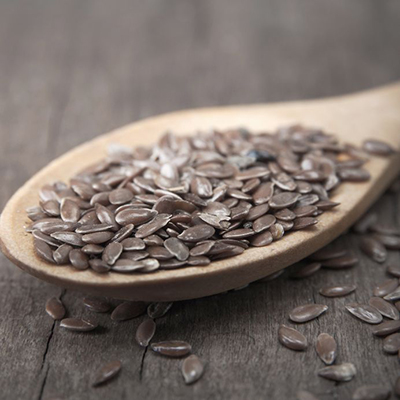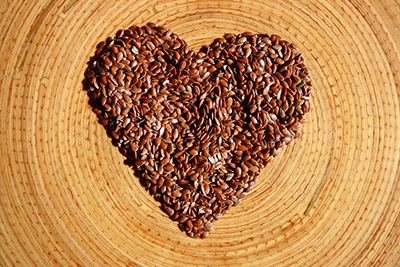Flax Seeds: Hype or superfood?
 Flax Seeds — A Small Seed with Lots of Nutrition
Flax Seeds — A Small Seed with Lots of Nutrition
Superfoods have recently gained popularity. Consumers are interested in adding foods to their diet that pack a big punch in terms of nutritional content and therapeutic benefit. One superfood with a very impressive range of benefits is the flax seed. Historical research has revealed that this small seed was cultivated 30,000 years ago,[1] and medical research continues to reveal benefits that will keep people eating this mighty seed for years to come.
Flax seeds contain several components that contribute to their health benefits. They contain alpha-linoleic acid (ALA), an omega-3 fatty acid. There are few concentrated vegetarian sources of omega-3 fats, and flax seeds contain the highest concentration.[2] Omega-3 fats are essential in the diet, as they cannot be produced by the body and are typically low in the North American diet. Omega-3 fats possess anti-inflammatory properties.[3] Decreasing inflammation is an important goal for overall health promotion and is useful in the treatment of a range of conditions such as heart disease, arthritis, and inflammatory bowel disease.
The flax seed also contains a substantial amount of fibre, another nutrient that many people consume in inadequate quantities. Fibre plays an important role in helping people to feel full, keeping cholesterol in check, and regulating digestion.[4]
One of the more unique components of flax is its very high concentration of lignans, a type of phytoestrogen. These plant-based estrogen-like compounds have effects on hormones within the human body.[5]
Flax can be added to the diet in several forms including the whole seed, ground seed, or oil. While the oil provides a concentrated source of flax’s omega-3 fats, it does not provide the fibre or lignans.
There are many ways to incorporate flax into the diet. Like all nuts and seeds, they can be easily added to oatmeal, cereal, or yogurt. The ground seeds can also be hidden in a variety of food items such as smoothies, meatballs, chilli, or pasta sauce. When baking, ¼ cup of ground flax seeds can be used in substitution for ¼ cup of flour. While there are many “flax-enhanced” products available, it is important to check the amount of flax in the product, as some contain such small quantities that they provide more decoration than nutritional benefit. Flax oil can be added to smoothies or salad dressings but should not be used for cooking because of its low heat tolerance.[6]
 Flax Seeds and Digestion
Flax Seeds and Digestion
One of the roles that flax seeds are best known for is packing a lot of fibre into a small seed. The term “fibre” refers to indigestible carbohydrates found in vegetables, fruits, nuts and seeds, and whole grains. Many North Americans consume as little as 5 to 10 grams daily, while the amount recommended for optimal health is 35 to 50 grams.[7] A two-tablespoon serving of flax seeds contains four grams of fibre.
Fibre plays an incredible role in a range of body functions, with the best-known being waste elimination. Because fibre cannot be digested, it passes through the digestive tract unchanged, adding bulk to bowel movements and increasing the speed at which waste travels through the digestive tract. As a result of more efficient elimination, harmful waste products spend less time in contact with the colon walls.[8]
It is known that about half of colorectal cancer cases can be attributed to poor diet and sedentary behavior. Dietary fibre intake is known to have a protective effect.[8] This may be due to the increased speed of movement or dilution of harmful substances in the stool. New evidence is suggesting that the bacteria in the digestive tract may be involved in the protective effect. These bacteria use dietary fibre as a food source and produce butyrate as a by-product. Although preliminary, animal studies have demonstrated that butyrate inhibits cancer cell growth and induces cancer cell death.[8]
The presence of fibre in a meal has benefits for blood-sugar regulation. Its presence in the digestive tract slows the absorption of carbohydrates and decreases the postmeal spike in blood sugar, which has significant benefits for weight management and diabetes.[7] A small study added 10 g of flax seed to the daily diet of participants with type 2 diabetes. After only one month, blood sugar levels had decreased by 20% and hemoglobin A1C, a measurement of high-blood-sugar exposure, decreased by 16%.[9]
Another benefit of high intake of indigestible fibre is that it promotes fullness after a meal. Research shows that when the calorie content of two meals is kept consistent, the meal with more fibre results in greater feelings of fullness and less hunger afterwards.[10] Additionally, when individuals are able to eat as much as they choose, an increase of 14 grams of fibre is associated with a 10% decrease in the calories consumed and, subsequently, weight loss.[10]
While many people are familiar with the idea that fibre improves bowel function, the benefits clearly extend to many other areas of health promotion.
 Flax Seeds and Heart Disease
Flax Seeds and Heart Disease
Heart disease is the number-one cause of death globally.[11] Heart attacks and strokes occur when the blood vessels that supply the heart or brain become obstructed with plaque. There are many factors that contribute to the development of plaque formation including high cholesterol, high blood pressure, and high levels of inflammation and oxidation. Flax seeds appear to benefit all of these risk factors.
In a recent study, postmenopausal women were provided with 38 g of flax seed or sunflower in the form of breads and baked goods. Both groups experienced a decrease in total cholesterol, but only the flax treatment produced a reduction in plaque-causing LDL cholesterol (14.7%).[12] Another study assigned patients with high cholesterol to three groups: a low-fat diet, a low-fat diet plus a statin (a common cholesterol medication), or a low-fat diet plus flax seeds. The group receiving flax seed experienced a significant reduction in total cholesterol and LDL cholesterol, and the results were no different compared to the group receiving the statin medication.[13]
While less documented, there have been studies that show that flax seeds have a blood-pressure-lowering effect. A large study of postmenopausal women supplementing with 40 grams of flax seed produced a significant reduction in systolic and diastolic blood pressure.[14] While these effects can be considered mild, it has been observed that reductions blood pressure of 3 mmHg can decrease coronary heart disease risk by 5%, stroke by 8%, and all-cause mortality by 4%.[15] As such, even small decreases in blood pressure can have a positive impact on overall heart-disease risk.
While blood pressure and cholesterol are some of the more well-known risk factors for heart disease, research is uncovering a significant role of inflammation and oxidation in the formation of plaques. The lignans found in the flax seed have been found to act as potent antioxidants.[16] Omega-3 fats are known to have anti-inflammatory action which inhibits plaque formation. Studies have shown that flax produces a decrease in several markers of inflammation and molecules responsible for adhesion of plaque to the vessel walls.[16]
The processes in the body that contribute to the onset of heart disease are numerous and complex. While the research is preliminary, it suggests that components found in flax seeds have the remarkable ability to interfere with many of these changes and may have a significant role to play in maintaining cardiovascular health.
 Flax Seeds and Hormones
Flax Seeds and Hormones
Estrogen is a hormone produced by the ovaries which plays important roles for reproductive health as well as numerous other functions within the body. The amount of estrogen present in the body must be kept within a fine balance — too little has a negative impact on bone health and cholesterol balance, and too much estrogen exposure increases the risk of breast and ovarian cancer, as seen in women who menstruate for more years of their life or who take hormone replacement therapy. Estrogen promotes cell growth through stimulation of estrogen receptors in these tissues. This growth is appropriate for many functions but can be inappropriate such as in the case of cancer.[17] Flax helps to minimize the negative effects of excess estrogen through several different mechanism.
Flax seeds contain phytoestrogens, molecules similar to the estrogen molecules produced in the body. Phytoestrogens have an inhibitory effect on the production of estrogen.[18] They are also able to interact with estrogen receptors but produce a milder effect than estrogen. If estrogen levels are low in the body, the phytoestrogens can have a stimulating effect, whereas if estrogen levels are high, the phytoestrogen’s weaker effect produces a reduction in stimulation of the estrogen receptors.[18] As a result, the overall effect of the phytoestrogen is balancing.
Flax also impacts the way hormones are disposed of by the body. When estrogen molecules are eliminated from the body, they go through a reaction in the liver which produces a few different estrogen by-products including 2-, 4- and 16-hydroxyestrogen. The 2 form has less estrogenic activity than the original compound, whereas the 16 form has more. It is known that women with higher levels of the 16 form of estrogen and lower levels of the 2 form have a higher risk of developing breast and ovarian cancer.[19][20] Flax-seed lignans have been shown to have a beneficial effect on the ratio of estrogen products by increasing the amount of 2-hydroxyestrogen production.[21]
Another way in which flax affects hormone balance is in the digestive tract. After the hormones are metabolized in the liver, they are transported into the digestive tract for excretion in the stool. However, hormones in the digestive tract can be reabsorbed and return to circulation in the body. By increasing the speed at which waste moves through the digestive tract, hormone reabsorption is decreased, thereby decreasing the amount of estrogen that is active with in the body.[22]
In addition to normalizing estrogen levels and activity in the body, which has a protective effect against breast and ovarian cancer, flax also has direct inhibitory actions on cancer. Phytoestrogens can act on proteins in the cell that are responsible for controlling cell proliferation and cell death. Several animal studies have demonstrated an ability to decrease the frequency of precancerous cell changes, tumors and tumor recurrence.[18]
Maintaining an appropriate balance of hormones with in the body can have a protective effect from some types of cancer. Flax seeds act in numerous ways to regulate the production, activity, and disposal of estrogen, as well as directly inhibiting cancer cells.
References
- Kvavadze, E., et al. “30,000-year-old wild flax fibers”. Science Vol. 325, No. 5946 (2009): 1359.
- Giada, M.L. “Food applications for flaxseed and its components: products and processing”. Recent Patents on Food, Nutrition & Agriculture Vol. 2, No. 3 (2010): 181–186.
- Wall, R., et al. “Fatty acids from fish: the anti-inflammatory potential of long-chain omega-3 fatty acids”. Nutrition Reviews Vol. 68, No. 5 (2010): 280–289.
- Howarth, N.C., E. Saltzman, and S. Roberts. “Dietary fiber and weight regulation”. Nutrition Reviews Vol. 59, No. 5 (2001): 129–139.
- Mense, S.M., et al. “Phytoestrogens and breast cancer prevention: possible mechanisms of action”. Environmental Health Perspectives Vol. 116, No. 4 (2008): 426–433.
- Vereshagin, A.G. and G.V. Novitskaya. “The triglyceride composition of linseed oil”. Journal of the American Oil Chemists’ Society Vol. 42, No. 11 (1965): 970–974.
- Lyon, M.R. and V. Kacinik. “Is there a place for dietary fiber supplements in weight management?” Current Obesity Reports Vol. 1, No. 2 (2012): 59–67.
- Huxley, R.R., M. Woodward, and P. Clifton. “The epidemiologic evidence and potential biological mechanisms for a protective effect of dietary fiber on the risk of colorectal cancer”. Current Nutrition Reports Vol. 2, No. 1 (2013): 63–70.
- Mani, U.V., et al. “An open-label study on the effect of flax seed powder (Linum usitatissimum) supplementation in the management of diabetes mellitus”. Journal of Dietary Supplements Vol. 8, No. 3 (2011): 257–265.
- Howarth, N.C., E. Saltzman, and S. Roberts. “Dietary fiber and weight regulation”. Nutrition Reviews Vol. 59, No. 5 (2001): 129–139.
- World Health Organization. Global status report on noncommunicable diseases 2010. Geneva, World Health Organization, 2011.
- Arjmandi, B.H., et al. “Whole flaxseed consumption lowers serum LDL-cholesterol and lipoprotein(a) concentrations in postmenopausal women”. Nutrition Research Vol. 18, No. 7 (1998): 1203–1214.
- Mandaşescu, S., et al. “Flaxseed supplementation in hyperlipidemic patients”. Revista medico-chirurgicală a Societăţii de Medici şi Naturalişti din Iaşi Vol. 109, No. 3 (2005): 502–506.
- Dodin, S., et al. “The effects of flaxseed dietary supplement on lipid profile, bone mineral density, and symptoms in menopausal women: a randomized, double-blind, wheat germ placebo-controlled clinical trial”. The Journal of Clinical Endocrinology and Metabolism Vol. 90, No. 3 (2005): 1390-1397
- Prasad, K. “Flaxseed and cardiovascular health”. Journal of Cardiovascular Pharmacology Vol. 54, No. 5 (2009): 369–377.
- Cornelissen, V.A., et al. “Impact of resistance training on blood pressure and other cardiovascular risk factors. a meta-analysis of randomized, controlled trials”. Hypertension Vol. 58, No. 5 (2011): 950–958.
- Prasad, K. “Hypocholesterolemic and antiatherosclerotic effect of flax lignan complex isolated from flaxseed”. Atherosclerosis Vol. 179, No. 2 (2005): 269–275.
- Yager, J.D. and N.E. Davidson. “Estrogen carcinogenesis in breast cancer”. The New England Journal of Medicine Vol. 354, No. 3 (2006): 270–282.
- Mense, S.M., et al. “Phytoestrogens and breast cancer prevention: possible mechanisms of action”. Environmental Health Perspectives Vol. 116, No. 4 (2008): 426–433.
- Gupta, M., A. McDougal, and S. Safe. “Estrogenic and antiestrogenic activities of 16α- and 2-hydroxy metabolites of 17β-estradiol in MCF-7 and T47D human breast cancer cells”. The Journal of Steroid Biochemistry and Molecular Biology Vol. 67, No. 5–6 (1998): 413–419.
- Muti, P., et al. “Estrogen metabolism and risk of breast cancer: a prospective study of the 2:16α-hydroxyestrone ratio in premenopausal and postmenopausal women”. Epidemiology Vol. 11, No. 6 (2000): 635–640.
- Haggans, C.J., et al. “Effect of flaxseed consumption on urinary estrogen metabolites in postmenopausal women”. Nutrition and Cancer Vol. 33, No. 2 (1999): 188–195.
- Cohen, L.A., et al. “Dose-response effects of dietary fiber on NMU-induced mammary tumorigenesis, estrogen levels and estrogen excretion in female rats”. Carcinogenesis Vol. 17, No. 1 (1996): 45–52.

 Stores
Stores